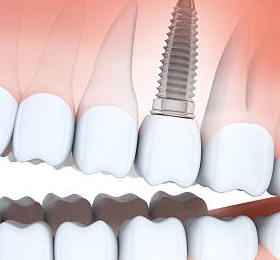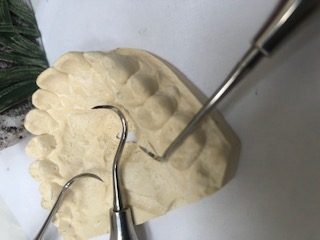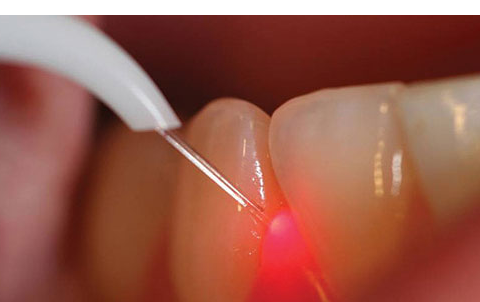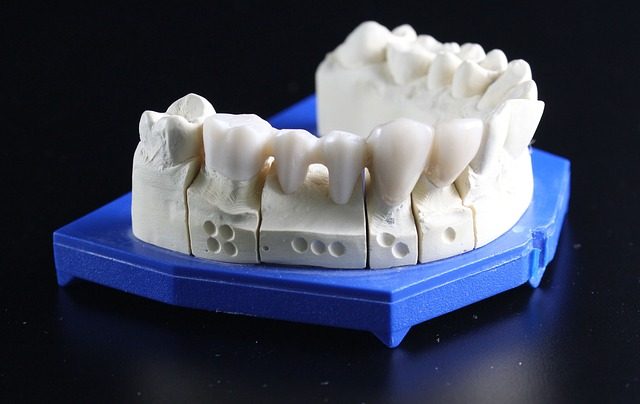
Why Get A Partial Denture?
If you’re missing one or more teeth, it’s always worth exploring your options for replacement. A set of teeth work together to function in very specific ways. As a group they’re really looking out for each other, sharing the heavy load of chewing. When front teeth step outside the role of tearing food and end up grinding it like molars do, the wear and tear can accelerate their demise. Or if one side is intact and the other side is full of gaps, you can guess which side will do all the chewing and absorb the extra burden. On top of the functional problems, a happy smile just might not feel right to you. Smiles that should shine with warmth and confidence are quickly repressed.
Yes, missing teeth can even affect our personalities.
Partial dentures sit squarely on a list of options to fill in your smile.
An economical choice that can be made from a number of different materials. This appliance often works to replace one tooth or a dozen teeth. A partial denture made with a thin, lightweight metal base allows teeth and gums to be firmly bonded to it. These often last for many years and sometimes provide a foundation for other teeth to be added if they’re lost in the future. But a removable partial denture can also be crafted with non-metallic components. While this variation may not last as long, they can be an excellent alternative. Advancements in material technology give us more options than ever, and your dentist can discuss possibilities with you. You might want to consider dental implants as part of the plan, too.

How Does It Work?
A partial denture relies on the remaining teeth for critical support and stability. That means the condition of those teeth needs to be considered closely to make sure they’re up to the task. This includes the quality of the jaw bone holding the tooth which is a lot like the foundation of a house. When a foundation crumbles, it really doesn’t matter what the rest of the house looks like. Teeth aren’t much different. Your dentist evaluates numerous factors as together you decide if a partial denture is right for you.
A partial denture offers other benefits, including the ability to remove it and clean properly around your natural teeth. Serving as a single solution to multiple lost teeth, each appliance is highly customized for your mouth. This allows for a design that fits into the existing bite, color, and overall appearance of your smile. It’s also a solution that can be used for an indefinite period of time until you’re ready for a more permanent solution, such as implant-supported teeth. In some cases, an implant or two combined with a partial denture offers outstanding service as well. Partial Denture Blogging and Partial Dentures Blog with us at DentalChat.com. Local Dental Chat about Dentures with us. Denture Repair Blog link here at DentalChat. We are discussing Denture Repairs and ways of fixing Partial Denture Repair of broken dentures.
Despite the benefits, a foreign appliance can be difficult for some patients to tolerate even when made with as much care as we apply to the process. While it’s often hard to predict how each patient will adapt to a removable partial denture, your dentist can discuss the steps and design with you. Most importantly, they’ll cover your options and give you enough information so you can decide what’s best for you.
We did Partial Denture Blogging, Partial Dentures Chat and Partial Denture Treatment Blog in this article.
If you don’t have a dentist or you’re dealing with more questions about what to expect after tooth extraction, you’re in the right place. Find a Local Dentist or Find Dentists Near You with us. DentalChat provides the best platform to connect with licensed U.S.-based dentists. You can ask questions online and even connect with a nearby office that can help you with your needs. Feel free to jump on and see how we can help now or in the future!

Dental Implants Blog: Your Dental Implant Procedure Info
Not so long ago, you had very few options if you lost a tooth. Today, dental implants often give you the best opportunity to return to the normal chewing and an intact smile after tooth loss. As you consider the possibilities, a few questions usually come to mind. Of course, you realize the long-term benefits of the procedure, especially knowing that you’re going with an option that will make your life better every day for years. But you might be wondering about the near future of the process. Many patients ask the question, “What is the dental implant procedure like?”
Dental Implant Information and Dental Implants Blog: What is Dental Implants and Your Dental Implant Procedure Info online blog. Dental implants have become one of the best ways to fix a missing tooth or more in the mouth. In the last 20 years, more and more people are placing dental implants into the mouth. The dental implant is a screw-like product that is kind of screwed into the jaw bone. There is a lot of dental planning and expertise needed to have dental implants placed into the mouth.
Dental Planning Always Pays Off
Your comfort should be the most important part of every visit. We take every measure to make that central to your dental implant experience. If we need to include specialists in our plan, work with a provider who shares the same philosophy as the specialists they work with. If you prefer sedation, seek out an office that offers it. To ensure success, it’s vital that a personalized road map is created for your return to full dental function. The best practices now use digital imaging technology and other records to guide the entire process. Good planning pays dividends in life…and dentistry. Also, make sure to get a good Local Dentist Consult about what the dental treatment plan will include.
You’ll likely be surprised at the experience during the placement of a dental implant. The modern dental anesthetic numbs the area profoundly so that you don’t feel anything when dental implants are placed into the jaw, and with experienced dentists, hands start placing the implant. A mini-guide hole creates a path for a small implant cylinder to be carefully placed and slowly threaded into the site. A smooth cover is placed over the implant that remains in place during the healing period.
There are many temporization options that are possible so you can smile confidently from day one. In some cases, a temporary crown may be created and delivered that day. Since every patient’s procedure is different, your dentist will help you decide what will work best during the healing period. Within a short time, the sterile implant surface begins integrating into the bone. The healing period usually lasts from 3-6 months as the implant bonds within your jaw bone. Most patients experience very little discomfort after implant surgery, especially when compared to a tooth removal procedure.
A Perfect Finish
After 3-4 months of healing, a crown will be custom-made and attached to the implant with a small screw or dental cement. Your dentist chooses from a variety of components that allow an optimal result when completing the final stage. Customizing the process of your tooth replacement from planning to the final placement of your new tooth makes all the difference in the outcome. Choose a dentist with experience and advanced education in the exciting area of dental implant technology. That choice will ensure you experience the best of modern dentistry! Ask Dentist an Dentist Question or Post Your Dental Question with us at DentalChat.com. Ask Dentists Dental Implant Questions and more.
If you don’t have a dentist or you’re dealing with more dental questions about what to expect after tooth extraction, you’re in the right place. DentalChat provides the best platform to connect with licensed U.S.-based dentists. You can ask questions online and even connect with a nearby office that can help you with your needs. Feel free to jump on and see how we can help now or in the future!

Why Do I Have Bad Breath?
Have you ever had someone step back from you and immediately you think “Why do I have bad breath?” While our breath may be a source of embarrassment, it might be telling you something more, too. Understanding what’s behind bad breath is the first step toward creating a more pleasant breeze with your words.
What Creates That Odor?
When the wind blows across the earth around us, it brings us the scent of whatever it moves over. It could be pleasant wildflowers or a pile of horse manure, but odor particles bind to receptors in our noses and our brains process the message.
As our warm air rushes out of our lungs and across the linings of the throat and mouth, it does something similar. Any odors emitting from the tissue or teeth are picked up and carried out to nearby noses. Garlic carries a bit of a reputation thanks to powerful molecules with a distinct odor profile. “Coffee breath” also leaves its mark on a conversation.
Sometimes, bad breath is related to medical conditions. Diabetes, bronchitis, liver disease, or respiratory tract infections can create distinctive odors. A long list of prescription drugs often reduce saliva production and result in a dry mouth problem. If you haven’t had a physical recently with blood tests, it’s always a good idea to check these possibilities. If you’re taking an anti-depressant or high blood pressure medication and your mouth is dry, that could be contributing to the problem. But don’t stop taking your medication, just remember to let us know.
The Real Problem
While bad breath can come from systemic or medication sources, odds are it’s all about microscopic bacteria. Our mouths are loaded with bacteria and their by-products, including gases and toxins. Some bacteria emit a sulfur gas that just smells bad and easily mixes with moving air. But just because so many bacteria make the mouth their home, it doesn’t mean bad breath has to go along with the situation.
When you wake up in the in the morning, you’re going to throw out a little morning breath. During your sleep, your saliva output drops by 90%. This dry environment is perfect for bacterial overgrowth and they sulfur gases they produce.
Cavities, bleedings gums, excess tartar, or unwashed dentures involve bacteria-related problems, too. There’s a difference though. These problems need to be checked and treated by your dentist. So if you’re struggling with bad breath, make sure you’re up-to-date on your dental check-ups. Gum disease tends to have a distinct smell that can’t be brushed away. These problems are don’t always involve pain, and odor can be your only obvious warning signal.
Got it. But How Do I Stop Bad Breath?
You might be meticulous with your daily routine. Odd are that you brush and floss like a fiend. To top it off, you never miss the hour with your favorite hygienist every six months. But you can’t shake the frustration of “Why do I have bad breath?”
It’s easy to overlook the quiet, yet rowdy, member of the mouth: The tongue. If you inspect the surface of the tongue under a microscope, you see a thickly textured surface that helps us taste and feel. It’s a little like a carpet. Have you ever seen what comes out of a carpet after shampooing, even when it looks pretty tidy to the eye? That’s your tongue.
A slurry of food particles, bacteria, and dead cells gets embedded into this surface. A load of debris ends up stuck, and that can be a major factor of bad breath, even in conscientious patients. It then makes sense that learning to clean the tongue might make a big difference.
Using your regular toothbrush, brush your tongue as far back as you can without gagging. Scrub both sides and the top with vigor Include your favorite toothpaste to create a breath-freshening slurry to the task.
Getting Fresher
The best way to really freshen the tongue is to employ a tool designed to do it right. Tongue cleaners aren’t complicated, but they work. It’s a little bit like using a thatching rake on your backyard to drag out the dead stuff. A tongue cleaner could be just what the doctor ordered, and starting your day with this little trick might transform your world.
It’s not unusual to reach for a mouthwash if you’re trying to freshen your breath. Unfortunately, you may compound the problem. Most rinses contain alcohol and dry out the mouth, which then lowers the pH. Rinses are analgous to perfume for the mouth. Perfume covers up body odor, but it doesn’t fix the core problem. A mouth rinse might cover up the offensive odor for awhile, but it doesn’t solve the problem.
Alcohol-free rinses work differently and offer a valid way to experiment with a swish and spit routine. These products cancel out sulfur gas, create a neutral pH, and wipe out 99% of the odor-causing bacteria on contact. Closys products enjoy approval by the American Dental Association, and boast a solid record of helping people asking “Why do I have bad breath?”
Be very careful about covering up bad breath with mints or other candies and methol cough drops. Most are full of sugar and increase the acidity of the mouth. You could go from no cavities to a whole bunch of them with this destructive habit. A good alternative includes xylitol-sweetened candies, and you’ll find good options online or in your local pharmacy. Xylitol is a natural sweetener that actually disturbs your bad mouth bacteria and prevents them from thriving. Use it.
The Bottom Line
At this point, you should have a few more ideas about “Why do I have bad breath?” To put it succinctly, here’s the take-home message:
- Check out your general health with your physician. Be sure to discuss side-effects of any medications you’re taking.
- Don’t skip regular dental visits and stick with treatment recommendations. Follow-through pays.
- Establish the best home oral care habits including brushing and flossing. Consider an electric toothbrush or water flosser.
- Add a tongue-scraper to your morning routine.
- Check out the innovative fresh-breath products from Closys.
At DentalChat, we bring patients and dentists together online for real conversations. Our real-time platform helps you find the answers and resources you need. Looking for a dentist in your area? Start chatting now and get the help you need.

Dental Questions people ask online – Ask a Dentist Question?
We are at Dental Chat helping people get their dental questions answered online. What is the type of Dental Questions people ask online?
There are various types of dental problems people have – that they want to have dental answers to or want to get better information.
These dental questions would include many things – here are some dental subjects we get asked. It would be about dental topics such as tooth pain, cosmetic dental care and orthodontic questions.
Orthodontics Questions Chat:
Many people experience various braces and orthodontics treatment problems – this can include: My brace bracket fell off, what should I do? Or another common orthodontist question gets asked is, my gums are very inflamed after having braces for 6 months, etc. Other dental questions get asked about braces is – how long should orthodontics treatment take? If have a local orthodontist question or want more information about orthodontics, can use this orthodontics dental question chat blog link.
If there are dental questions want to ask or Ask a Dentist Question? If want to, people can post a dental question – can click this Dental Chat link https://dentalchat.com/patient/create-post
We welcome our users feedback and suggestions. Dental Chat is founded to help people with their dental care.

Dental Laser, Periodontal Gum Laser Therapy to treat Gum Disease
- Dental Laser, Periodontal Gum Laser Therapy to treat Gum Disease:
We are at DentalChat looking to better inform our viewers and site users more dental information. We will be Dental Laser Chat Online & Dentist Laser Chatting about benefits in this article. This Dental Blog will discuss Dental Laser Treatment. Dental Lasers are used by dentists in many different ways – with Periodontal Gum Laser Therapy for treatment of gum inflammation being one of them. Basically, the dental laser is used to remove inflamed gum tissue from around the tooth root and coronal portion / around the teeth where the inflammation is.
In the 1990s, medical CO2 and Nd:YAG lasers units with the first pulsed Nd:YAG laser designed specifically for the dental care market place was released – in the last decade, newer forms of dental lasers have come into the dental market place. Dental Laser companies are pushing great new technology innovation the last decade.
Dentist Laser Chat – One of the big benefits using Dental Laser Surgery is not having to use so much anesthesia and usually less pain post-op. for Dentist One of the main advantages of using dental laser therapy for treating some forms of gum disease is that it requires less anesthesia and generally, if less invasive than having to go in and do a incision to access the inflammation. Generally, because of this – the recovery time can be less than with regular gum surgery. Laser gum surgery should only be performed with dentists that have the right training for it – as each device has various wavelengths and user criteria to follow.

Gum Disease Chat – Crown Lengthening Procedure Discussion
Gum Disease Chat and more – here with us @ DentalChat.com. Gum disease comes in various degrees, with peridontitus being one of the worst type or severe form of gum disease. We are looking for more dental content on here, to help our users gain more dental information.
DentalChat.com was founded by a dentist and an IT health care technology professional – looking to bring something fresh and innovate into the dental space. Great time to market online with us.
Local Emergency Dental Chatting Online & Local Emergency Dentists Chat online with us – We are looking to discuss various dental subjects involving dental care. For this blog, want to discuss crown lengthening procedure.
Why is a Crown Lengthening procedure done – for one, there caries, tooth malformation, attrition, excessive tooth reduction, erosion, genetic variations and many times because of tooth fracture below the gum line. So, if a dentist wants to place a crown, and a lot of the tooth is broken or not visible easily because it is broken around the gum line. The dentist will remove part of the gum to show more of the tooth, so a good crown impression can be done – so, the crown will be placed on the tooth easily and with a good fit.
Crown Lengthening is done by dentists when more area is needed for placement of a dental crown. Now a days, with advance dental technology – lasers are sometimes used to do this procedure as well.
Online Dental Care Chatting, Online Dentists Chat communication features, Local Dentist Chat Online Marketing, Online Dental Chat business listing and Local Dental Chat Networking Online with us at DentalChat. We are looking to network with local dental blogs and dental information companies.

Difference between a Partial Denture and a Complete Denture / Dentist Chatting
Difference between a Partial Denture and a Complete Denture / Dentist Chatting:
We want to discuss various dental topics on here. What is the difference between a Partial Denture and a Complete Denture? This is quite simple. A partial denture is when there are several teeth missing in the mouth, and the partial denture is used to replace the several teeth or single missing tooth. A partial denture sometimes has various types of hooks or attachments to go around the teeth, to hold it in place.
A COMPLETE DENTURE or FULL DENTURE is when all the teeth in the mouth have been extracted & a complete denture is used to replace the missing teeth. Denture(s) are generally removable appliances. Now a days, they are also used with Dental Implants sometimes, though usually an attachment placed inside the denture to hold more steadily in place. That is, dentures are used in conjunction sometimes with dental implants – though this may be more costly. The denture / dental implant(s) combo maybe a good option for those that have had all their teeth extracted – a retained denture / dental implants attachment to provide more support for the person to chew.
Excellent time to network and market online with us @ Dentalchat.com. Dentist Chatting Online and Local Emergency Dental Chat online with us. We are networking with local dentists and dental businesses.
